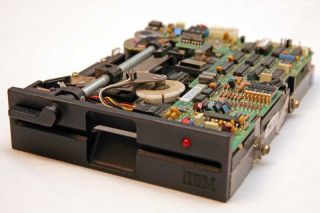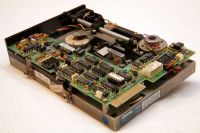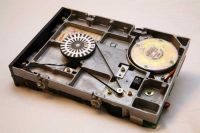QumeTrak 142 5¼-inch Floppy Disk Drive
The QumeTrak 142 was a double-sided, double-density 5¼-inch floppy disk drive. The drive was fitted to the IBM 5155 and many other PCs.
In common with most 5¼-inch drives, it had no outer casing as such, and so could easily be damaged when servicing. The [{{SERVER}/downloads/manuals/qume/QumeTrak-142-floppy-drive.pdf service guide] suggests inserting a sheet of blank paper between the heads before removal to avoid the heads making contacted with each other.
Later drives, such as the N.E.C. FD1157C, had a partial outer casing covering the head assembly and circuitry.
The device has a 14-pin DIP socket for a terminator resistor network (for example a Beckman 899-3-R150).
Specifications
| Single Density | Double Density | |
|---|---|---|
| Capacity (per disk) | Unformatted 250k, Formatted 163k | Unformatted 500k, Formatted 327k bytes |
| Recording Density | 2938 BPI | 5876 BPI |
| Track Density | 48 TPI | 48 TPI |
| Cylinders | 40 | 40 |
| Tracks | 80 | 80 |
| Recording Method | FM | MFM |
| Rotational Speed | 300 RPM | 300 RPM |
| Transfer Rate | 125k bits/sec | 250k bits/sec |
| Average Latency | 100 ms | 100 ms |
| Average Access Time | 160 ms | 160 ms |
| Track-to-track Seek Time | 12 ms (6 ms optional) | 12 ms (6 ms optional) |
The drive weighed 980g.
Reliability
- Soft Error Rate: One error per 109 bits read
- Hard Error Rate: One error per 1012 bits read
- Seek Error Rate: One error per 106 seeks
- MTBF: 8000 Power-on-hours under typical usage (25% duty cycle)
- Component Life: 5 Years
- Media Life: 3 x 106 Passes per track and 30,000 insertions
Manufacturers Description
The QumeTrak 142 Flexible Disk Drive is an advanced design that is based on Qume's manufacturing experience with its standard size flexible disk drive models. Qumes proven design head carriage assembly and ceramic read/write (R/W) head with tunnel erase are employed for long media life.
Efficient access time (12ms track-to-track) is assured through a highly accurate and reliable steel band type head positioning mechanism. Media rotation is belt driven from a DC spindle drive motor, eliminating the need for AC power to the unit. This drive provides a low cost, direct access, 48 TPI track density data storage device for soft sectored flexible (floppy) diskettes.
The QumeTrak 142 provides unformatted storage capacity of 250k bytes on single density or 500k bytes on double density two-sided flexible diskettes.
The QumeTrak 142 is a half-height design. When two QumeTrak 142 drives are stacked, each drive occupies exactly one-half the installation height (1.625 inches) of a standard 5.25 inch drive.
Standard features include:
- Only positive DC power required (no AC or negative DC);
- Low heat dissipation;
- Industry standard interface;
- Four drive daisy chain capability;
- Internal write protect circuitry;
- In Use LED activity indicator on the front bezel.
Servicing
Common problems this many years from manufacture include:
- Dirty heads. Gently wipe over both heads with a cotton bud dipped in isopropynol.
- Sticky head mechanism. The service manual states that a 50g weight attached to the head mechanism should be enough to pull the head to either stop, with the drive on end as required. In practice the head mechanism should move easily. It is prone to become sticky especially at the ends of travel, in which case the drive may fail a BIOS seek test (reporting floppy drive failure).
This can be easily resolved by first cleaning the three rails thoroughly (again with cotton bud dipped in isopropynol) and then applying a little grease again with a cotton bud, and moving the heads a few times to get an even and thin coating on the rails. Finally wipe away any excess. - Stiff lock handle, with poor spring tension when released. Again a lubrication issue. Close the door lock, and remove the screw from the door pin actuator at the front of the drive (a single cross-head screw) and slide it back a little. Next stand the drive on end as required and apply one drop of 3-in-one oil to the door lock shaft ends, such that it runs down in to the plastic bearing. Reposition and secure the door pin actuator and open the drive lock, and then apply a little grease to the spring cam half way along the shaft on the faces that will turn against the spring. Finally operate the lock a few times to work the oil and grease in fully.
- Dirty optos. There are three opto sensors - read-only tab, disk position, and head track 0 position. All three can be cleaned with a cotton bud dipped in isopropynol that has first been compressed such that it will fit in the openings.


